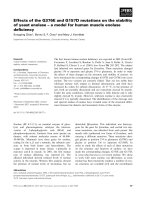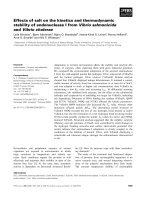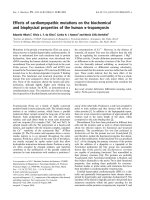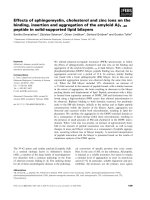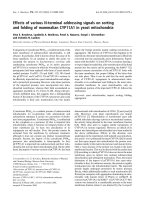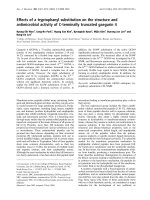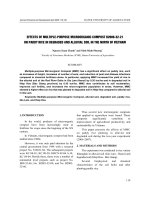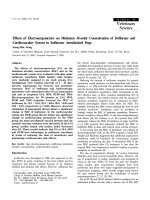Báo cáo khoa học: "Effects of irrigation and nitrogen fertiliser on the growth and nutrient relations of Prunus avium L and ’Colt’ (Prunus avium x Prunus pseudocerasus) in the nursery and after transplantation" doc
Bạn đang xem bản rút gọn của tài liệu. Xem và tải ngay bản đầy đủ của tài liệu tại đây (624.38 KB, 13 trang )
Original
article
Effects
of
irrigation
and
nitrogen
fertiliser
on
the
growth
and
nutrient
relations
of
Prunus
avium
L
and
’Colt’
(Prunus
avium
x
Prunus
pseudocerasus)
in
the
nursery
and
after
transplantation
NA
Hipps,
KH Higgs,
LG Collard,
TJ
Samuelson
Horticulture
Research
International,
Perennial
Crops
Department,
East
Malling,
Kent
ME19
6BJ,
UK
(Received
18
January
1993;
accepted
8
June
1994)
Summary —One—year—old
seedlings
of
Prunus
avium
and
hardwood
cuttings
of ’Colt’
were
lined
out
and
nitrogen
fertiliser
was
applied
at
rates
of
between
0
and
9
g
per
tree
either
with
or
without
irriga-
tion.
Nitrogen
fertiliser
had
no
effect
on
the
growth
and
leaf
mineral
concentrations
of
either
geno-
type.
Irrigation
increased
the
growth
of
both
genotypes
and
the
concentrations
of
P
and
K
in
the
leaves
but the
concentrations
of
Mg
and
Ca
were
reduced.
The
following
year
the
trees
were
lifted
and
replanted.
The
plants
of
’Colt’
that
had
previously
received
irrigation
produced
longer
total
shoot
lengths
than
unirrigated
plants,
whereas
there
was
no
difference
for
P
avium.
The
residual
effect
of
irri-
gation
slightly
reduced
the
concentration
of
P
in
the
leaves
of
both
genotypes,
yet
the
concentrations
of
N,
K,
Ca,
Mg
and
Mn
were
unaffected.
Prunus
I
nutrition
I
nursery
I
transplant
I
growth
Résumé —
Effets
de
l’irrigation
et
de
la
fertilisation
azotée
sur
la
croissance
et
la
nutrition
de
Prunus
avium
et
de
«Colt»
(Prunus
avium
x
Prunus
pseudocerasus)
en
pépinière
et
après
transplantation.
De jeunes
semis
de
1 an
de
Prunus
avium
et
des
boutures
ligneuses
du
cultivar
«Colt»
(Prunus
avium
X
Prunus
pseudocerasus)
ont
été
plantés
en
ligne
avec
un
faible
espacement
(0,3
m).
Un
engrais
azoté
a
été
appliqué
à
des
niveaux
variant
de
0
à
9
g
par
arbre,
avec
ou
sans
irri-
gation.
Pour les
2
types
de
Prunus,
la fertilisation
azotée
n’a
pas
eu
d’effet,
ni
sur
la
croissance,
ni
sur
la
concentration
en
éléments
minéraux
dans
les
feuilles.
L’irrigation
a
augmenté
la
croissance
et
les
concentrations
en
P et
K
dans
les
feuilles
chez
les
2 types
de
Prunus.
En
revanche,
les
concentrations
en
Mg
et
Ca
ont
été
réduites.
L’année
suivante,
les
arbres
ont
été
amachés
et
transplantés.
Les
plants
de
«Colt»
qui
avaient
été
précédemment
irrigués
ont produit
alors
une
longueur
totale
de
pousse
plus
importante
que
les
plants
non
irrigués.
Au
contraire,
pour
Prunus
avium,
aucune
différence
n’est
appa-
rue.
L’effet
résiduel
de
l’irrigation
a
consisté
en
une
réduction
de
la
concentration
en
P
dans
les
feuilles
pour
les
2
types
de
Prunus,
alors
que
les
concentrations
en
N,
K,
Ca,
Mg
et
Mn
n’étaient
pas
affectées.
Prunus
/
nutrition
/ pépinière
/
transplantation
/
croissance
INTRODUCTION
Nearly
90%
of
the
UK’s
consumption
of
for-
est
products
is
imported
(Forest
Industry
Committee
of
Great
Britain,
1987)
and
there
is
increased
interest
in
the
use
of
broadleaf
trees
as
an
alternative
crop
in
lowland
areas
previously
used
for
agriculture.
Cherry
is
a
very
suitable
native
tree
species
for
planting
in
these
areas
as
it
grows
quickly,
the
timber
has
high
value
and
is
much
in
demand
(Pryor,
1988).
Tree
seedlings
are
likely
to
receive
mini-
mum
soil
management
after
planting
into
farmland
due
to
their
low
values
and
long
growth
cycles
compared
with
other
agricul-
tural
or
horticultural
crops.
Ideally,
newly
planted
trees
should
establish
well
with
rapid
growth
soon
after
outplanting.
The
quality
of
trees
used
for
outplanting
may
be
influ-
enced
by
fertiliser
application
and
irrigation
in
the
nursery.
Millard
and
Proe
(1991)
found
that
sycamore
(Acer
pseudoplatanus)
seedlings
grown
in
pots,
and
receiving
a
high
rate
of
nitrogen
in
year
1
and
a
low
rate
in
year
2
(after
transplanting)
were
unable
to
sustain
early
leaf
growth
rates
later
in
year
2,
whereas
those
seedlings
receiving
the
treatments
vice
versa
greatly
increased
their
leaf
growth
later
in
year
2.
Van
de
Driessche
(1984)
states
that
with
coniferous
seedlings
the
benefit
of
nursery
fertilisation
to
survival
after
transplanting
could
not
be
consistently
demonstrated.
In
several
experiments
(Knight,
1957;
Switzer
and
Nelson,
1963;
Bell,
1968;
Mullin
and
Bowdery,
1978)
no
effect
was
shown
but
the
survival
and
growth
of
outplanted
Douglas
fir
Pseudot-
suga
menziesii
(Mirbel)
were
increased
by
fertilisation
which
also
increased
seedling
size
(Smith
et al,
1966).
Little
is
known
about
the
influence
of
irrigation
on
nursery
tree
seedling
nutrient
relations
and
even
less
information
is
available
on
the
influence
of
irrigation
on
seedling
nutrient
relations
and
subsequent
growth
and
survival
after
out-
planting
(Duryea
and
McClain,
1984).
This
report
investigates
the
interaction
of
nitrogen
fertiliser
and
irrigation
on
the
growth
and
nutrient relations
of
cherry
seedlings
and
cuttings
in
the
liner
nursery
and
the
subsquent
performance
after
trans-
plantation.
MATERIALS
AND
METHODS
Site
The
trial
was
carried
out
at
Horticulture
Research
International
(HRI),
East
Malling,
on
a
soil
of
the
Barming
Series
(Furneaux,
1954),
which
has
approximately
60-120
cm
fine
sandy
loam
over-
lying
ragstone.
Bare-rooted
1-year-old
seedlings
of
Prunus
avium
and
pre-rooted
hardwood
cut-
tings
of
’Colt’
taken
from
hedges
in
December
1988
were
planted
at
the
end
of
March
1989
in
N-S
rows
which
were
1
m
apart.
Within
the
row
each
plot
consisted
of
10
trees
spaced
at
0.3
m.
The
trees
were
lifted
on
8
March
1990
and
replanted
in
adjacent
land
on
the
same
day,
in
a
N-S
direction
in
rows
2
m
apart.
Within
each
row
the
trees
were
spaced
2
m
apart.
Cherry
trees
had
not
been
grown
in
the
soil
previously
so
there
was
no
risk
of
replant
disease.
Soil
treatments
The
soil
treatments
were chosen
considering
the
interaction
of
irrigation
and
nitrogen
fertiliser.
The
fertiliser,
ammonium
nitrate,
was
applied
at
4
rates,
0,
3,
6
or
9
g
N
total
per
tree
per
year,
either
broadcast
over
a
3
x
0.4
m
strip
along
the
row
with
split
dressings
on
9
May
and
27
June
1989
or
dissolved
in
water
via
trickle
irrigation
(fertiga-
tion)
on
alternate
days
over
100
d
between
early
May
and
mid-August.
On
days
that
fertigation
treatment
was
not
applied,
the
relevant
trees
were
irrigated.
Fertigation
or
irrigation
was
applied
at
a
rate
of
1.7
I per
tree
per
day.
In
1990
no
nitrogen
fertiliser
was
applied
but
half
of
the
total
number
of
transplanted
trees
(which
represented
all
the
previous
years
treat-
ments)
were
trickle
irrigated,
4
I per
tree
being
given
daily
from
April
to
October.
Experimental design
In
1989
each
plot
contained
2
groups
of
experi-
mental
trees
with
guard
trees
between
and
at
each
end.
One
group
contained
5
trees
harvested
during
the
year
for
growth
and
nutrient
analysis.
The
other
group
contained
2
trees
which
were
measured
non-destructively
during
1989
and
then
lifted
and
replanted
so
that
the
residual
effects
of
the
first
year
treatments
could
be
measured
after
transplantation
in
1990.
Thus
in
1990
each
plot
contained
2
trees.
In
1989
the
experimental
design
was
a
2
x
2
x
4
factorial
with
7
replicates
of
each
treatment
combination.
Each
replicate
was
a
single
row
of
16
plots
and
within
each
replicate
the
16
treat-
ment
combinations
were
arranged
in
4
incom-
plete
blocks
of
4
plots.
The
allocation
of
treat-
ment
combinations
to
blocks
was
such
that
each
of
the
3
degrees
of
freedom
of
the
variety
x
nitro-
gen
interaction
and
of
the
irrigation
x
nitrogen
and
variety
x
irrigation
x
nitrogen
interactions
was
confounded
in
2
or
3
of
the
7
replicates
In
1990
the
experimental
design
was
the
same
as
in
1989
except
that
there
was
an
additional
treatment
as
1
of
each
pair
of
trees
in
the
original
treatment
was
trickle
irrigated.
Tree
growth
Trees
were
harvested
from
each
of
the
16
plots
in
1
replicate
on
18
May,
12
June,
3
July,
31
July,
21
August
and
18
September
1989.
The
trees
were
cut
at
ground
level
and
records
made
of
basal
stem
diameter
and
the
number
and
length
of
shoots
for
each
tree.
The
stems
and
leaves
were
separated
and
dried
in
an
oven
for
48
h
at
85°C
to
determine
dry
matter
weight.
Shoot
lengths
and
stem
diameters
were
mea-
sured
on
21
February
1990
and
25
January
1991
on
all
the
trees
used
for
transplanting;
these
trees
were
lifted
on
21
March
1991
and
fresh
weights
recorded.
Mineral
analysis
Leaf
and
stem
samples
from
all
the
harvested
trees
were
used
for
mineral
analysis.
Leaf
sam-
ples
were
taken
on
10
September
1990
only
from
the
trees
which
had
received
0
or
9
g
N
in
1989.
Analysis
of
the
leaves
was
carried
out
after
a
Kjeldahl
digestion
in
concentrated
H2
SO
4
con-
taining
0.1 %
Se
as a
catalyst
and
H2O2.
Nitrogen
was
determined
on
a
Technicon
Autoanalyzer
using
the
indophol
blue
method
and
P
was
deter-
mined
using
the
molybdenum
blue
reaction.
K,
Ca,
Mg
and
Mn
were
determined
by
atomic
emis-
sion
or
absorption
spectrophotometry.
Soil
samples
were
taken
from
control
plots
on
18
May
1989,
P
was
extracted
with
0.5
M
NaHCO
3
(pH
8.5),
using
5
g
soil
in
100
ml
extrac-
tant
(MAFF,
1981).
Exchangeable
K
was
deter-
mined
by
extraction
of
10
g
soil
with
50
ml
of
1
M
NH
4
NO
3
(MAFF,
1981).
NH
4
-N
and
NO
3
-N
were
determined
by
extraction
of
40
g
moist
soil
with
200
ml
of
2
M
KCl
(MAFF,
1981).
The
soil
char-
acteristics
are
shown
in
table
I.
RESULTS
Rainfall,
soil
moisture
deficit
and
plant
water
status in
1989
Total
rainfall
was
30%
below
average
for
the
period
April
to
September
(table
II).
The
maximum
soil
moisture
deficit
was
93
mm
adjacent
to
the
unirrigated
trees
and
43
mm
for
irrigated
trees
(table
II).
Drought
stress
was
reduced
by
irrigation
as
leaf
water
potential
and
stomatal
conductance
were
consistently
increased
(table III).
Plant
growth
and
nutrient
status
before
transplantation
in
1989
At
planting
the
mean
height
and
stem
diam-
eter
were
61
cm
and
5.6
mm,
respectively,
for
the
’Colt’
cuttings
and
35
cm
and
3.4
mm,
respectively,
for
the
P
avium
seedlings.
The
differences
between
’Colt’
and
P
avium
in
height
(P<
0.001,
standard
error
of
the
dif-
ference
(SED)
0.6
cm,
69
df)
and
stem
diameter
(P<
0.001,
SED
0.08
mm,
69
df)
were
highly
significant.
Nitrogen
fertiliser
had
no
influence
on
the
measured
growth
parameters
of
either
genotype
and
so
the
results
presented
here
are
averaged
over
the
different
nitrogen
levels
used.
Irrigation
increased
the
total
new
shoot
length
for
both
P
avium
and
’Colt’
(table
IV);
for
P
avium,
this
was
due
to
an
increase
in
mean
shoot
length
only,
whereas
for’Colt’ both
mean
shoot
length
and
num-
ber
of
shoots
per
tree
increased.
In
all
cases
’Colt’
had
a
shorter
mean
shoot
length
than
P
avium.
Growth
curves
were
fitted
to
the
data
col-
lected
from
the
trees
harvested
during
the
season.
Gompertz
curves
were
found
to
provide
a
satisfactory
fit
and
parameters
were
estimated
by
minimizing
the
residual
sum
of
squares
on
a
log-transformed
scale
to
allow
for
the
increasing
variance
of
the
data
over
time.
Fitted
curves
did
not
differ
significantly
between
nitrogen
levels
for
any
of
the
variables.
Growth
analysis
of
total
shoot
length
(fig
1)
showed
that
early
increases
in
shoot
length
caused
by
irrigation
persisted
throughout
the
season
and
that
the
shoot
extension
of
’Colt’ continued
later
than
that
of
P
avium.
The
relative
total
shoot
exten-
sion
rates
for
each
genotype
(ie
the
aver-
age
slope
of
the
curves
when
plotted
on
a
log
scale)
were
similar.
Dry
matter
At
the
first
sampling
date
in
May
very
little
shoot
growth
had
occurred
and
the
mean
aerial
dry
weights
of
’Colt’ and
P
avium
were
2.1
and
5.6
g,
respectively.
Although
the
total
aerial
dry
weight
of
’Colt’
was
greater
than
that
of
P
avium
during
the
growth
period
(fig
2),
their
maximum
rela-
tive
growth
rates
were
similar
at
0.050
and
0.046
d
-1
for
P
avium
and
’Colt’,
respec-
tively.
Thus,
differences
in
the
total
aerial
dry
matter
weights
of
the
2
types
of
cherry
at
the
final
harvest
were
mainly
due
to
the
ini-
tial
differences
in
size
at
planting.
Irrigation
increased
dry
matter
accumulation
for
both
cultivars.
Leaf
mineral
concentrations
Nitrogen
fertiliser
had
no
significant
effect
(P>
0.05)
on
the
concentrations
of
N,
P,
K,
Ca,
Mg
and
Mn
in
the
leaves.
Irrigation
did
not
influence
the
concentration
of
N
in
the
leaves
of
either
genotype
during
the
sea-
son
(fig
3)
but
the
concentrations
of
P
and
K
were
significantly
(P
<
0.05)
increased
by
irrigation
after
June,
whereas
the
concen-
trations
of
Mg
and
Ca
were
reduced
(P
<
0.05).
The
total
foliar
content
of
minerals
was
derived
by
multiplying
mean
leaf
con-
centration
by
total
leaf
dry
weight
(ie
com-
bining
data
presented
in
figures
2
and
3).
At the
final
harvest,
there
was
a
significant
(P <
0.01)
interaction
between
genotype
and
irrigation
for
the
total
foliar
content
of
Ca
and
Mg.
The
total
foliar
contents
of
Ca
per
plant
of
’Colt’
and
P
avium
were
1
046
and
503
mg,
respectively,
for
unirrigated
trees
and
1
503
and
408
mg
(SED
47
mg,
3
df),
respectively,
for
irrigated
trees.
The
total
foliar
contents
of
Mg
per
plant
of
’Colt’
and
P
avium
were
166
and
56
mg,
respectively,
for
unirrigated
trees
and
242
and
47
mg
(SED
6
mg,
3
df)
respectively
for
irrigated
trees.
In
May,
’Colt’
had
significantly
greater
leaf
concentrations
of
N
(P<
0.001),
P
(P<
0.001),
K
(P<
0.05),
Mg
(P<
0.05),
Ca
(P<
0.05)
and
Mn
(P<
0.01)
than
P avium (fig 3).
Mg
and
Ca
these
effects
persisted
dur-
ing
the
whole
season
whereas
for
all
the
other
minerals
they
did
not.
After
June
the
mean
concentration
of
K
was
greater
in
leaves
of
P avium than
’Colt’.
Leaves
of
P
avium
showed
some
symp-
toms
of
Mg
deficiency
during
the
season
which
were
characterised
by
an
interveinal
purple
colour
developing
on
the
basal
leaves
followed
by
chlorosis
and
necrosis.
Stem
and
shoot
mineral
concentrations
Irrigation
did
not
significantly
(P>
0.05)
influ-
ence
the
concentration
of
any
of
the
miner-
als
in
the
stem
and
shoots
(fig
4).
Early
in
the
season
the
concentrations
of
N and
Ca
in
the
stems
and
shoots
of
’Colt’
were
greater
than
in
P
avium.
From
May
until
the
end
of
July
the
concentration
of
K,
Mg
and
Mn
were
significantly
higher
in
the
stems
and
shoots
of
P
avium
than
in
those
of
’Colt’.
Rainfall,
soil
moisture
deficit
and
plant
water
status
in
1990
Total
rainfall
was
45%
below
average
for
the
period
April
to
September
(table
II).
The
maximum
soil
moisture
deficit
was
106
mm
adjacent
to
the
unirrigated
trees
and
93
mm
for
irrigated
trees
(table
II).
Drought
stress
was
consistently
reduced
by
irrigation
as
leaf
water
potential
and
stomatal
conduc-
tance
were
consistently
increased
(table
III).
Plant
growth
and
nutrient
status
after
transplantation
in
1990
Nitrogen
fertiliser
applied
in
1989
had
no
residual
effect
on
the
growth
of
the
trees
in
1990.
Irrigation
in
1989
caused
an
increase
in
the
total
new
shoot
length
and
number
of
shoots
of
’Colt’
in
the
following
year
whereas
for
P
avium
it
had
the
opposite
effect
on
new
shoot
length
and
no
effects
on
number
of
shoots
(table
IV).
Thus,
the
1989
application
of
irrigation
reduced
the
mean
shoot
length
of
both
genotypes
in
1990.
’Colt’
had
a
significantly
greater
total
new
shoot
length,
number
of
shoots
and
mean
new
shoot
length
than
P
avium
(P <
0.001).
The
irrigation
of
the
transplanted
trees
in
1990
(table
V)
significantly
increased
stem
diameter
(P <
0.01),
total
new
shoot
length
(P <
0.001),
number
of
shoots
(P <
0.001)
and
mean
shoot
length
(P<
0.001)
for
both
genotypes.
Leaf
mineral
analysis
Nitrogen
fertiliser
applied
in
1989
had
no
effect
on
the
concentration
of
N
in
the
leaves
in
1990.
The
residual
effect
of
irrigation
in
1989
(table
VI)
slightly
but
significantly
decreased
P
concentration
in
the
leaves
of
both
culti-
vars
(P <
0.01)
but
the
concentrations
of
the
other
minerals
were
unaffected.
The
differences
between
genotype
were
similar
to
those found
in
the
previous
year,
ie ’Colt’
had
a
greater
concentration
of
P
(P<0.05),
Ca
(P<0.001),
Mg
(P<0.001)
and
Mn
(P<
0.001)
in
leaves
than
P avium,
but
a
lower
concentration
of
K
(P<
0.001).
Basal
leaves
of
P
avium
seedlings
again
showed
some
visual
symptoms
of
Mg
defi-
ciency.
The
irrigation
of
the
transplanted
trees
in
1990
(table
VII)
had
a
large
influence
on
the
concentration
of
all
the
minerals
in
the
leaves
except
N;
P
(P <
0.001)
and K
(P <
0.01)
were
significantly
increased
whereas
Ca
(P <
0.01),
Mg
(P <
0.01)
and
Mn
(P <
0.01)
were
reduced.
The
soil
at
HRI,
East
Malling,
mineralises
approximately
50-70
kg
N
ha-1
year
-1
(Greenham,
1976)
and
a
further
40-50
kg
N
ha-1
year
-1
may
be
deposited
from
the
atmosphere
in
southern
and
eastern
Eng-
land
(Goulding,
1990).
The total
uptake
of
N
into
the
shoots
and
leaves
of
the
most
vig-
orous
trees
accounted
for
approximately
77
kg
N
ha-1
year
-1
.
Although,
the
plants
may
not
have
access
to
all
the
mineralised
nitro-
gen
and
some
nitrogen
is
lost
through
den-
itrification
and
by
leakage
due
to
drainage,
the
quantities
of
mineralised
nitrogen
were
in
excess
of
uptake.
Thus,
the
lack
of
growth
response
to
nitrogen
fertiliser
and
the
large
response
to
irrigation
confirms
that
even
for
the
high
density
of
plants
employed
in
the
liner
nursery
(1989)
availability
of
water
was
more
limiting
to
growth
than
a
lack
of
nitrogen.
A
similar
lack
of
response
to
a
nursery
fertiliser
application
of
80
kg
N
ha-1
to
Malus
rootstocks
was
observed
by
Asamoah
(1984).
Leaf
water
potential
of
irrigated
trees
was
often
low
in
the
field
due
to
high
evaporative
demand
and
not
necessarily
low
soil
mois-
ture
content.
Leaf
water
potentials
of
field-
grown
irrigated
apple
trees
have
also
been
found
to
be
<
-1
MPa
(Higgs
and
Jones,
1991).
Leaf
water
potentials
as
low
as
-1
MPa
for
the
irrigated
cherry
trees
in
our
experiment
did
not
affect
stomatal
func-
tioning
whereas
for
the
unirrigated
trees
similar
leaf
water
potentials
reduced
stom-
atal
conductance.
Thus,
it
is
unlikely
that
trees
receiving
irrigation
were
unable
to
tran-
spire
and
therefore
take
up
nutrients
due
to
excessive
drought
stress.
In
the
study
reported
here
all
leaf
nutrient
concentrations
of ’Colt’ were
within
the
limits
generally
considered
adequate
for
growth
whereas
those
for
P
avium
were
on
the
bor-
derline
for
this
species
(Van
den
Burg,
1985;
Reuter
and
Robinson,
1986).
The
concen-
tration
of
Mg
in
leaves
of
’Colt’
was
always
greater
and
the
concentration
of
K
lower
than
those
of
P
avium,
yet
no
deficiency
symptoms
were
seen.
Ystaas
(1990)
has
also
reported
higher
K
concentrations
in
cherry
trees
on
P
avium
rootstocks
than
on
’Colt’.
Potassium
is
known
to
antagonise
the
uptake
of
Mg
(Mengel
and
Kirkby,
1982)
and
low
leaf
Mg
concentration
in
fruit
trees
is
often
associated
with
high
levels
of
K,
even
in
soil
with
low
available
K
(Boynton
and
Oberly,
1966).
From
the
results
of
this
experiment
it
is
not
possible
to
determine
whether
the
differences
in
leaf
Mg
concen-
tration
of
the
2
genotypes
was
due
to
either
an
intrinsically
poorer
uptake
of
Mg
by
P
avium
or
a
preferred
uptake
of
K
which
antagonised
uptake
of
Mg
compared
with
’Colt’.
However,
this
is
the
subject
of
a
fur-
ther
investigation
which
has
confirmed
that
a
clonal
source
of
P
avium
has
the
same
sensitivity
to
Mg
deficiency
as
seedling
P
avium when
compared
with ’Colt’
(Troyanos,
unpubished
data).
Thus,
genetic
rather
than
cultural
factors
influence
the
susceptibility
of
cherry
to
Mg
deficiency
and
there
is
potential
to
use
selection
and
breeding
to
overcome
this
problem.
This
is
very
rele-
vant
to
a
crop
which
is
unlikely
to
receive
many
fertiliser
applications.
Irrigation
reduced
water
stress
in
the
nursery
and
had
a
positive
influence
on
P
and
K
concentration
and
a
negative
influ-
ence
on
Ca
and
Mg
concentration
in
the
leaves.
Trickle
irrigation
has
been
shown
to
increase
the
concentration
of
extractable
P
in
the
soil
(Bacon
and
Davey,
1992)
and
the
concentration
of
P
in
the
leaves
of
mature
fruit
trees
in
some
years
(Goode
and
Ingram,
1971;
Atkinson,
1986).
Atkinson
(1986)
suggests
that
apple
tree
roots
under
irrigated
grass
have
a
limitation
to
P
uptake
mid-season
compared
with
roots
under
bare
unirrigated
soil
due
to
a
reduced
total
root
length,
which,
in
turn,
provides
fewer
sites
for
infection
with
vesicular
arbuscular
mycor-
rhizae.
However,
the
value
of
mycorrhizae
to
field-grown
cherries
is
unknown.
In
our
experiment,
irrigation
increased
leaf
P
con-
centration
from
mid-season
onwards
and
some
unreplicated
samples
of
root
systems
indicated
that
the
root
length
of
both
type
of
cherry
was
increased
in
the
presence
of
irrigation
(data
not
presented).
Other
work-
ers
have
also
shown
that
the
root
length
of
Prunus
is
increased
in
the
presence
of
irri-
gation
(Richards
and
Cockcroft,
1975).
Grass,
a
possible
source
of
mycorrhizal
infection,
was
not
present
in
the
nursery,
so
improvement
in
P
uptake
under
irrigation
was
likely
to
be
due
to
a
combination
of
improved
availability
from
the
soil,
an
increase
in
size
of
root
system,
and
reduced
water
stress.
The
slight
reduction
in
the
con-
centration
of
P
in
the
leaves
of
both
types
of
cherry
after
transplantation
for
trees
previ-
ously
irrigated
is
not
readily
explicable
and
requires
further
investigation.
For
P
avium
the
reduction
in
leaf
Ca
and
Mg
concentration
caused
by
irrigation
was
due
to
a
dilution
effect
as
the
total
foliar
con-
tent
of
these
minerals
did
not
differ
signifi-
cantly
between
the
irrigated
treatments.
For
’Colt’
the
total
foliar
content
of
Ca
and
Mg
was
greater
for
the
irrigated
treatment
so
the
reduction
in
concentration
cannot
be
assigned
to
a
simple
dilution
effect.
The
lower
Ca
and
Mg
concentrations
caused
by
irrigation
in
the
leaves
may
also
have
been
caused
partly
by
antagonism
from
the
increased
K
concentration.
CONCLUSION
On
fine
sandy
loam,
nitrogen
fertiliser
applied
in
the
nursery
had
no
effect
on
the
growth
or
leaf
nutrient
concentration
of
either
genotype
either
in
the
nursery
or
after
trans-
plantation.
Irrigation
applied
in
the
nursery
and
after
transplantation
increases
the
shoot
growth
of
both
genotypes.
Thus
water
availability
is
more
important
than
supplementary
nitro-
gen
in
determining
the
growth
and
estab-
lishment
of
cherry
on
this
fertile
soil.
Irrigation
has
a
differential
effect
on
the
nutrient
relations
of
the
2
genotypes.
This
may
be
deleterious
for
P
avium
with
respect
to
Mg
nutrition
where
increased
growth
and
K
uptake
are
apparently
not
matched
by
Mg
uptake.
In
the
year
after
transplantation
the
larger
trees
of
’Colt’
that
had
received
irrigation
in
the
nursery
produced
more
total
new
shoot
growth
than
those
previously
unirrigated,
whereas
for
P
avium
there
was
no
differ-
ence
in
subsequent
growth.
Nursery
irriga-
tion
was
subsequently
beneficial
for
’Colt’
but
not
for
P
avium
ACKNOWLEDGMENT
This
project
was
financed
by
the
Ministry
of
Agri-
culture,
Fisheries
and
Food
to
whom
thanks
are
due.
REFERENCES
Asamoah
TE
(1984)
Fruit
tree root
systems:
effects
of
nursery
and
orchard
management
and
the
conse-
quences
for
growth,
nutrient
and
water
uptake.
Ph
D
Thesis,
University
of
London,
UK
Atkinson
D
(1986)
The
nutrient
requirements
of
fruit
trees:
Some
current
considerations.
In:
Advances
in
Plant
Nutrition
Vol
2
(B
Tinker,
A
Lanshli,
eds).
Praeger,
New
York,
93-128
Bacon
PE,
Davey
BG
(1983)
Nutrient
availability
under
trickle
irrigation
1.
Distribution
of
water
and
Bray
No
1
phosphate.
Soil Sci Soc Amer J 46, 981-986
Bell
TIW
(1968)
Effect
of
fertilizer
and
density
pretreat-
ment
on
spruce
seedling
survival
and
growth.
HMSO,
London. For
Com
For
Res
67, 67, 35
p
Boynton
D,
Oberly
GH
(1966)
In:
Temperate
to
Tropical
Fruit
Nutrition
(N
Childers,
ed).
Horticulture
Publi-
cations,
New
Brunswick,
NJ
Duryea
ML,
McClain
KM
(1984)
Altering
seedling
physio-
logy
to
improve
reforestation
sucess.
In:
Seedling
Physiology
and
Reforestation
Sucess
(ML
Duryea,
GN
Brown,
eds),
Martinus
Nijhoff/Dr
W
Junk
Pub-
lishers,
Dordrecht,
77-114
Forest
Industry
Committee
of
Great
Britain
(1987)
Beyond
2000.
The
Forest
Industry
of
Great
Britain.
Agriculture
House,
Knightsbridge,
London
Furneaux
BS
(1954)
The
soils
of
East
Malling
Research
Station.
In:
East
Malling
Research
Station
Annual
Report
for
1953,
67-69
Goode
JE,
Ingram
J
(1971)
The
effect
of
irrigation
on
the
growth,
cropping
and
nutrition
of
Cox’s
Orange
Pippin
apple
trees.
J
Hort
Sci 46,
195-208
Goulding
KWT
(1990)
Atmospheric
deposition.
Institute
of Arable
Crop
Research
Report
1989, 67,
The
Lanes
Agricultural
Trust,
cd
The
University
of
Bristol,
Harp-
enden, UK
Greenham
DWP
(1976)
The
fertiliser
requirement
of
fruit
trees.
Proc
Fert
Soc
157,
32
p
Higgs KH,
Jones
HG
(1991)
Water
relations
and cropping
of
apple
cultivars
on
a
dwarfing
rootstock
in
response
to
imposed
drought.
J
Hort
Sci 66,
367-379
Knight
H
(1957)
Growth
and
survival
of
experimental
plantations
of
Douglas
fir.
British
Columbia
Forest
Service,
Victoria,
Research
Note,
33,
22
p
MAFF
(1981)
The
analysis
of agricultural
materials,
HMSO,
London
Mengel
K,
Kirkby
EA
(1982)
Principles
of plant
nutri-
tion.
International
Potash
Institute,
Bern,
Switzer-
land
Millard
P,
Proe
MF
(1991)
Leaf
demography
and
the
seasonal
internal
cycling
of
nitrogen
in
sycamore
(Acer pseudoplatanus
L)
seedlings
in
relation
to
nitrogen
supply.
New
Phytol 113,
587-596
Mullin
RE,
Bowdery
L
(1978)
Effects
of
nursery
seedbed
density
and
top
dressing
fertilization
on
survival
and
growth
of
3+0
red
pine.
Can
J
For
Res
8,
30-35
Pryor SN
(1988)
The
silviculture
and
yield
of
wild
cherry.
Forestry
Commission
Bulletin
75,
HMSO,
London
Reuter
DJ,
Robinson
JB
(1986)
Plant
analysis -
An
inter-
pretation
manual.
Inkata
Press,
Melbourne,
Australia
Richards
D,
Cockcroft
B
(1975)
The
effect
of
soil
water
on
root
production
of
peach
trees
in
summer.
Aust
J
Agric Res 26,
173-180
Smith
JHG,
Kozak
A,
Sziklai
O,
Walters
J
(1966)
Rela-
tive
importance
of
seedbed
fertilization,
morpholog-
ical
grade,
site
provenance
and
parentage
to
juvenile
growth
and
survival
of
Douglas
fir.
For
Chron
42,
83-86
Switzer GL,
Nelson
LE
(1963)
Effects
of
nursery
fertility
and
density
on
seedling
characteristics,
yield
and
field
performance
of
Lobboly
Pine
(Pinus
taeda
L).
Soil
Sci
Soc
Am
Proc
27,
461-464
Van
den
Burg
J
(1985)
Foliar
analysis
for
determination
of
tree
nutrient
status -
a
compilation
of
literature
data.
Rapport
nr
414
Rijksinstituut
voor
onderzoek
in
de
bos-enlandschapsbouw.
De
dorschkamp,
Wageningen
Van
den
Driessche
(1984)
Soil
fertility
in
forest
nurs-
eries.
In:
Forest
nursery
manual:
production
of bare-
root seedlings
(ML
Duryea,
FD
Landis,
eds)
Martinus
Nijhoff/Dr
W
Junk
Publishers,
The
Hague,
63-74
Ystaas
J
(1990)
The
influence
of
cherry
rootstocks
on
the
content
of
major
nutrients
of
3
sweet
cherry
culti-
vars.
Acta
Hort 274,
517-519

